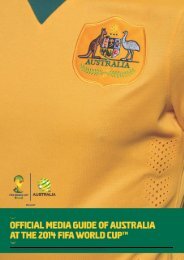OFFICIAL MEDIA GUIDE OF AUSTRALIA AT THE 2014 FIFA WORLD CUP BRAZIL 0
AFWC14MG
AFWC14MG
You also want an ePaper? Increase the reach of your titles
YUMPU automatically turns print PDFs into web optimized ePapers that Google loves.
FOOTBALL IN <strong>AUSTRALIA</strong><br />
Football in Australia has its roots in the early colonial days, with the first known match played between Wanderers<br />
and King's School at the Parramatta Common in Sydney. The match, played 14 August 1880 in front of almost 1000<br />
spectators, ended in a 5-0 win to the Wanderers.<br />
The first international match took place 42 years later, against trans-Tasman rivals New Zealand. Australia lost 1-3 in<br />
Dunedin in June 1922.<br />
Since then, and especially over the past 40 years, the sport of football has grown extensively in the country,<br />
cumulating with participation levels – especially for juniors – at an all-time high for any football code.<br />
Out of a total population of 23 million people, latest survey data shows that Australia has more than one million<br />
football participants, including well over 600,000 players officially registered with affiliated federations,<br />
incorporating junior, amateur, school, futsal, church and contract players.<br />
At the elite end of the scale, Australia regularly competes for a berth in the men’s and women’s World Cups, and the<br />
Olympic Games. Additionally, the various age-restricted continental championships throughout the diverse Asian<br />
Football Confederation provide elite players from all ages significant opportunities to gain international experience<br />
and exposure.<br />
The code has one of the most respected talent identification systems and youth development programs of any sport<br />
in Australia, culminating with the Australian Institute of Sport in Canberra. The National Youth League and National<br />
Youth Championships are more examples of the pathways that continue to lead to the production of champion<br />
men's and women's players.<br />
Since the early 1900s, the country’s elite football clubs competed in the various state leagues. In 1977, football was<br />
the first code in Australia to adopt a national league. In 2005 a vibrant and brand new national competition – the<br />
Hyundai A-League – was launched, attracting historically large crowds and a significant national TV audience.<br />
The domestic competition and development programs have combined to establish Australia as a major exporter on<br />
the world soccer stage, with many Australians featuring in top leagues throughout the world. The ongoing return of<br />
current and former national team players to take up renewed playing careers in the A-League demonstrates the full<br />
cycle of the investment in Australian talent.<br />
Football Federation Australia (FFA) is the governing body for football in Australia and is a member of Fédération<br />
Internationale de Football Association (<strong>FIFA</strong>), the international governing body for football. <strong>FIFA</strong> is made up of more<br />
than 200 other national associations, each of which are within one of six continental confederations. FFA has been a<br />
member of the Asian Football Confederation (AFC) since joining the body on January 1 2006.<br />
Australia's long-sought entry into the AFC brought enormous benefits to the game, adding a new dimension that<br />
seemed a dream just ten years ago.<br />
The FFA has an overall responsibility to administer, develop and promote football in Australia through its state and<br />
territory membership. Each of these governing bodies has a commitment to comply with the FFA constitution,<br />
applicable statutes, by-laws and regulations, and are responsible for the game within their region.<br />
Football Federation Australia is specifically responsible for the:<br />
– senior national men’s team (Socceroos)<br />
– under 23 national men’s team (Under 23s)<br />
– under 20 national men’s youth team (Young Socceroos)<br />
– under 17 national men’s youth team (Joeys)<br />
– senior national women's team (Westfield Matildas)<br />
– under 20 national women's team (Westfield Young Matildas)<br />
– under 17 national women's team (Westfield Women's Under 17s)<br />
– national men’s indoor (futsal) team (Futsalroos)<br />
– national paralympic football team (Pararoos)<br />
FFA's long-term vision is to establish Australia as a truly world-class football nation. In order to achieve this vision,<br />
FFA's business operations are structured across three core strategic pillars:<br />
– National Teams & Elite Player Development,<br />
– A-League & Competitions, and<br />
– Football Community.<br />
<strong><strong>OF</strong>FICIAL</strong> <strong>MEDIA</strong> <strong>GUIDE</strong> <strong>OF</strong> <strong>AUSTRALIA</strong> <strong>AT</strong> <strong>THE</strong> <strong>2014</strong> <strong>FIFA</strong> <strong>WORLD</strong> <strong>CUP</strong> <strong>BRAZIL</strong> 74





